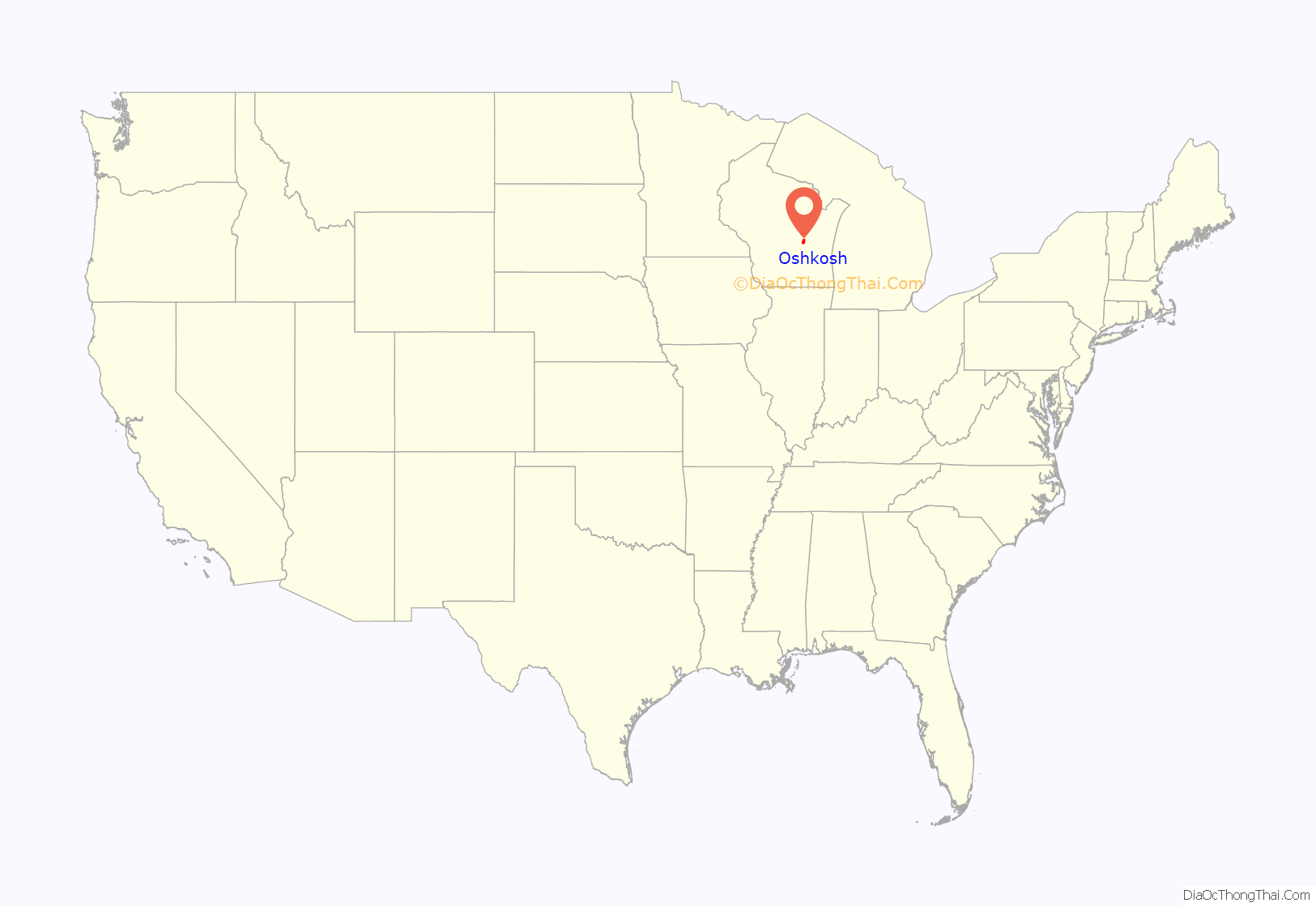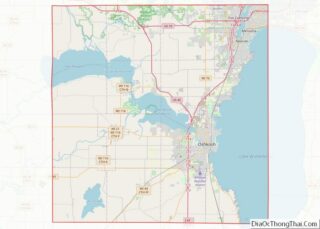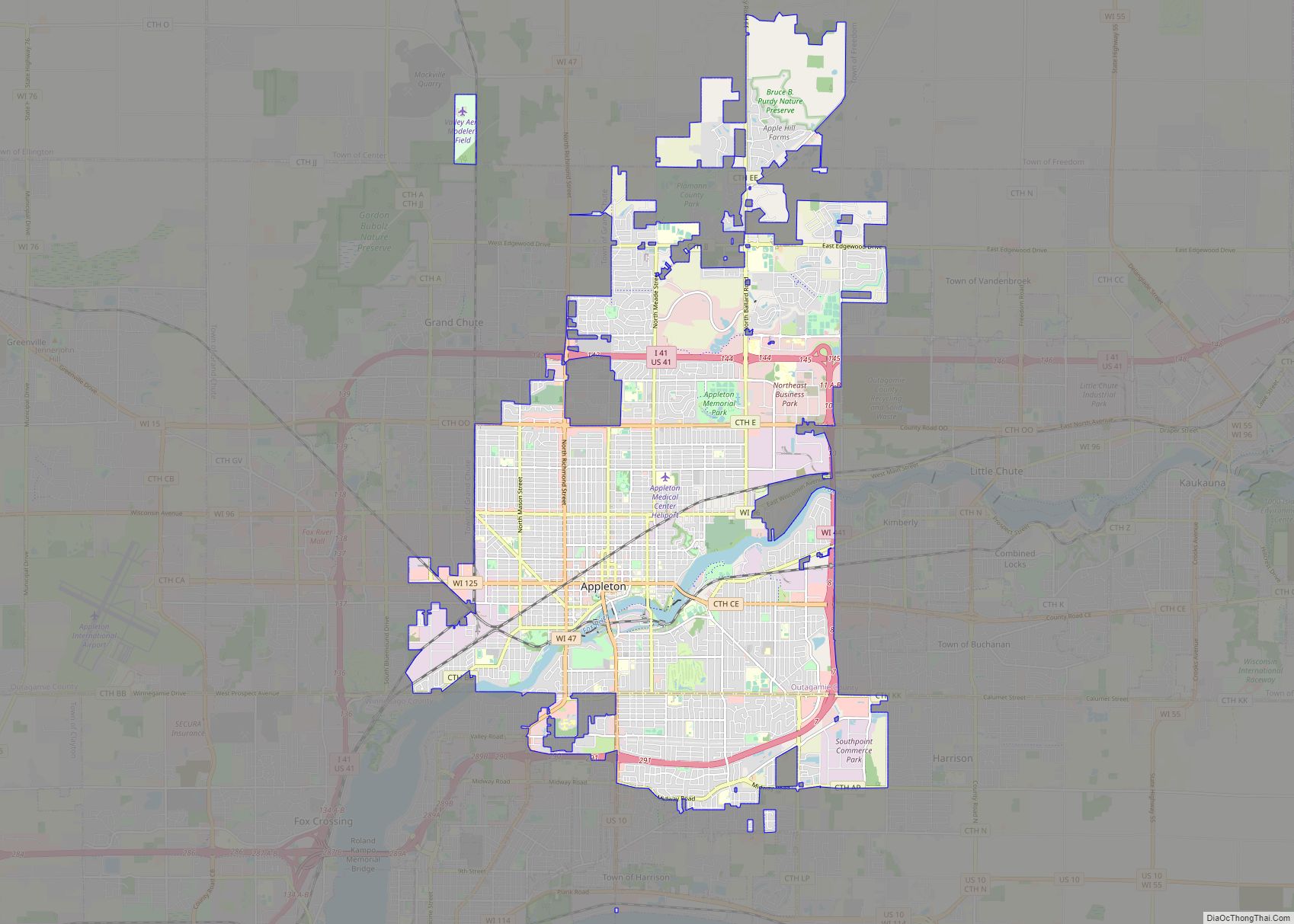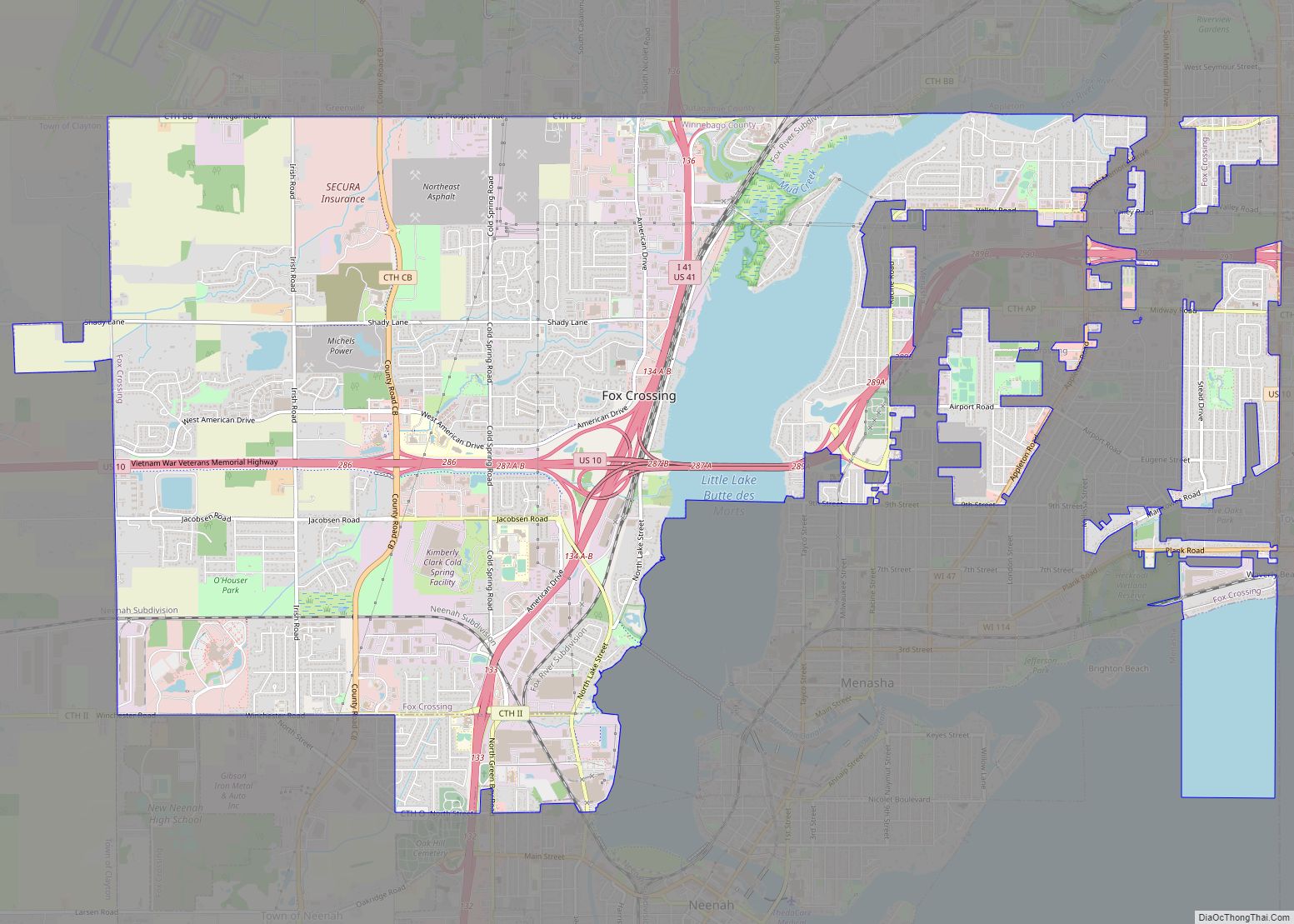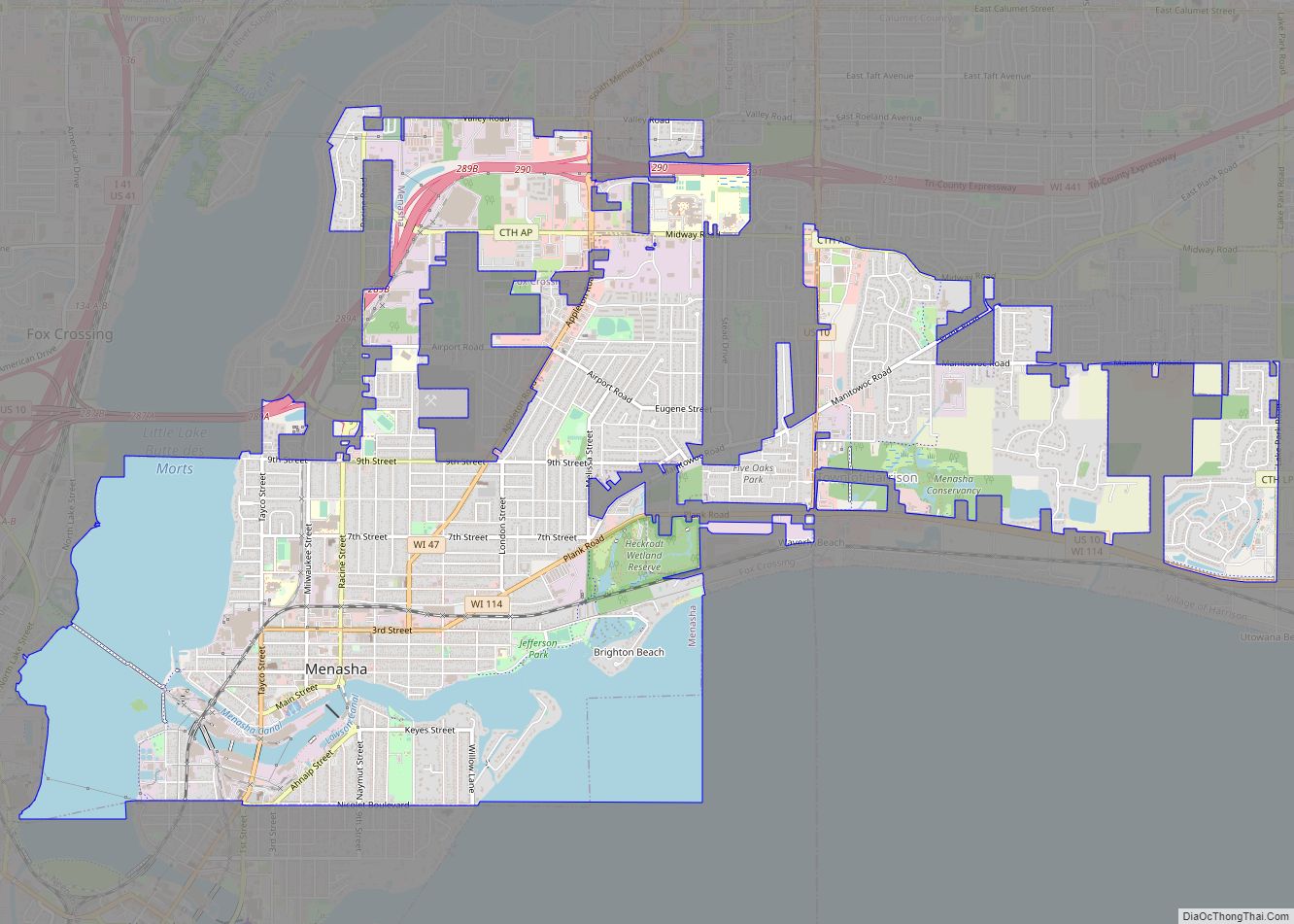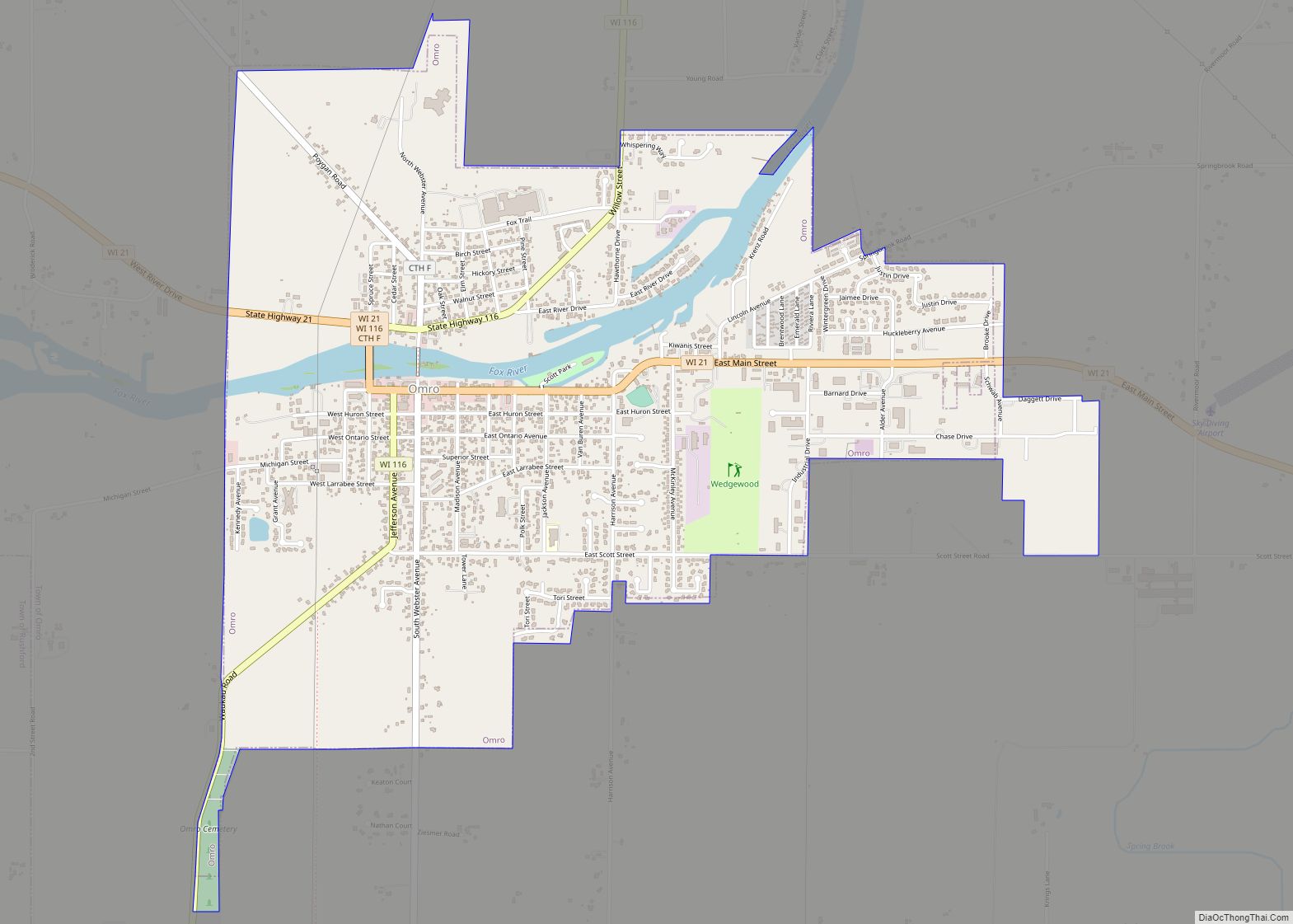Oshkosh is a city in and the county seat of Winnebago County, Wisconsin, United States. The city had a population of 66,816 in 2020, making it the ninth-largest city in Wisconsin. It is also adjacent to the Town of Oshkosh.
| Name: | Oshkosh city |
|---|---|
| LSAD Code: | 25 |
| LSAD Description: | city (suffix) |
| State: | Wisconsin |
| County: | Winnebago County |
| Elevation: | 790 ft (241 m) |
| Land Area: | 27.02 sq mi (69.98 km²) |
| Water Area: | 1.01 sq mi (2.61 km²) |
| Population Density: | 2,472.7/sq mi (954.7/km²) |
| Area code: | 920 |
| FIPS code: | 5560500 |
| Website: | www.ci.oshkosh.wi.us |
Online Interactive Map
Click on ![]() to view map in "full screen" mode.
to view map in "full screen" mode.
Oshkosh location map. Where is Oshkosh city?
History
Oshkosh was named for Menominee Chief Oskosh, (not a misspelling according to VisitOshkosh.com) whose name meant “claw” (cf. Ojibwe oshkanzh, “the claw”).
Although the fur trade attracted the first European settlers to the area as early as 1818, it never became a major player in the fur trade. The 1820s mining boom in southwest Wisconsin along with the opening of the Erie Canal shifted commercial activity away from the Fox River Valley and Green Bay. Soon after 1830, much of the trade moved west, as there had been over-trapping in the region.
Following the publicity caused by the Black Hawk War in 1832, there was increased interest in settling Wisconsin by whites from the East Coast, especially New York, Indiana, and Virginia, and by 1836 the cities of Milwaukee, Madison, Janesville, Beloit, and Fond du Lac were founded, with Madison the capital of a new territorial government, setting the stage for the economic and political importance of the southern part of the state. However, Oshkosh would continue to be one of Wisconsin’s top five largest cities into the twentieth century.
The establishment and growth of the wood industry in the area spurred development of Oshkosh. Already designated as the county seat, Oshkosh was incorporated as a city in 1853. It had a population of nearly 2,800.
The lumber industry became well established as businessmen took advantage of navigable waterways to provide access to both markets and northern pineries. The 1859 arrival of rail transportation expanded the industry’s ability to meet the demands of a rapidly growing construction market. At one time, Oshkosh was known as the “Sawdust Capital of the World” due to the number of lumber mills in the city, 11 by 1860.
During the Civil War, the 21st Regiment, Wisconsin Infantry, of the Union Wisconsin Volunteers was organized at Oshkosh, taking in many new recruits. This was one of two units organized in the state; the other was the 6th Regiment, Wisconsin Infantry, organized at Camp Randall, Madison. The 21st mustered on September 5, 1862, marching to Ohio and Louisville, Kentucky, where it participated in the fortification of Louisville later that year. It was attached to the Army of the Ohio and later to the Army of the Cumberland.
By 1870, Oshkosh had become the third-largest city in Wisconsin, with a population of more than 12,000. The community attracted a range of professional teachers, attorneys, doctors, businessmen, and others who helped it flourish. The Oshkosh Daily Northwestern newspaper (now the Oshkosh Northwestern) was founded around this time, as was the Oshkosh State Normal School (now the University of Wisconsin Oshkosh). Lumber continued as the mainstay of the city. By 1874, it had 47 sawmills and 15 shingle mills.
On April 28, 1875, Oshkosh had a “Great Fire” that consumed homes and businesses along Main Street north of the Fox River. The fire engulfed 70 stores, 40 factories, and 500 homes, costing nearly $2.5 million (or $67.3 million in 2022 money) in damage.
Around 1900 Oshkosh was home of the Oshkosh Brewing Company, which coined the marketing slogan “By Gosh It’s Good.” Its Chief Oshkosh brand became a nationally distributed beer.
The population of the city in 1910 was 33,062, making it the state’s fourth largest city, ahead of Madison and Green Bay.
The Oshkosh All-Stars played in the National Basketball League from 1937 to 1949, before the NBL and the Basketball Association of America merged to become the NBA. Oshkosh reached the NBL’s championship finals five times.
Historic districts
The city has a total of 33 listings on the National Register of Historic Places. Some area entrepreneurs and businessmen made their fortunes in the lumber industry. Many made significant contributions to the community, in both politics and supporting philanthropic organizations. Following devastating fires in the mid-1870s, new buildings were commissioned in Oshkosh that expressed a range of good design: for residential, commercial, civic and religious use.
The many structures which make up the city’s historic areas are largely a result of the capital and materials generated by the lumber and associated wood manufacturing industries. Oshkosh had six historic districts as of October 2011. They include the Algoma Boulevard, Irving/Church, North Main Street, Oshkosh State Normal School on the University of Wisconsin–Oshkosh campus, Paine Lumber Company, and Washington Avenue historic districts.
The city had 27 historic buildings and sites individually listed on the NRHP as of October 2011. Eleven are houses, four are churches, and the remainder include schools, colleges, a bank, a fire house, an observatory, the Winnebago County Courthouse, and a cemetery where many of the entrepreneurs are buried.
Oshkosh Road Map
Oshkosh city Satellite Map
Geography
Oshkosh is located at 44°1′29″N 88°33′4″W / 44.02472°N 88.55111°W / 44.02472; -88.55111 (44.024983, −88.551336).
According to the United States Census Bureau, the city has a total area of 26.61 square miles (68.92 km), of which, 25.59 square miles (66.28 km) is land and 1.02 square miles (2.64 km) is water.
Climate
In the most recent climatological normal has a hot-summer humid continental climate (Köppen: Dfa) near the 22 °C threshold (the average of the hottest month is 22.2 °C). Summer days are warm to hot with cool to mild nights. Winters are cold and long with moderate snowfall. Precipitation peaks from late spring to early fall.
See also
Map of Wisconsin State and its subdivision:- Adams
- Ashland
- Barron
- Bayfield
- Brown
- Buffalo
- Burnett
- Calumet
- Chippewa
- Clark
- Columbia
- Crawford
- Dane
- Dodge
- Door
- Douglas
- Dunn
- Eau Claire
- Florence
- Fond du Lac
- Forest
- Grant
- Green
- Green Lake
- Iowa
- Iron
- Jackson
- Jefferson
- Juneau
- Kenosha
- Kewaunee
- La Crosse
- Lafayette
- Lake Michigan
- Lake Superior
- Langlade
- Lincoln
- Manitowoc
- Marathon
- Marinette
- Marquette
- Menominee
- Milwaukee
- Monroe
- Oconto
- Oneida
- Outagamie
- Ozaukee
- Pepin
- Pierce
- Polk
- Portage
- Price
- Racine
- Richland
- Rock
- Rusk
- Saint Croix
- Sauk
- Sawyer
- Shawano
- Sheboygan
- Taylor
- Trempealeau
- Vernon
- Vilas
- Walworth
- Washburn
- Washington
- Waukesha
- Waupaca
- Waushara
- Winnebago
- Wood
- Alabama
- Alaska
- Arizona
- Arkansas
- California
- Colorado
- Connecticut
- Delaware
- District of Columbia
- Florida
- Georgia
- Hawaii
- Idaho
- Illinois
- Indiana
- Iowa
- Kansas
- Kentucky
- Louisiana
- Maine
- Maryland
- Massachusetts
- Michigan
- Minnesota
- Mississippi
- Missouri
- Montana
- Nebraska
- Nevada
- New Hampshire
- New Jersey
- New Mexico
- New York
- North Carolina
- North Dakota
- Ohio
- Oklahoma
- Oregon
- Pennsylvania
- Rhode Island
- South Carolina
- South Dakota
- Tennessee
- Texas
- Utah
- Vermont
- Virginia
- Washington
- West Virginia
- Wisconsin
- Wyoming
